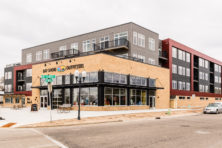Practice for Life: Sturgeon Bay autism program aims for happy, productive citizens
- Share
- Tweet
- Pin
- Share

Opening doors is the goal of the Sturgeon Bay School District’s autism education program, and not just for students in the program, but for other students in the school, teachers, parents, potential employers and the community at large.
“With it being Autism Awareness Month, we need to let people know. We just want to scream, this is successful! This is not going away,” said Deb Doyle, autism support person/teacher K-12.
To that end, students in the new 6-12 Autism program – for students in grades 6 through 12 – will perform during an open mic night of poetry and music in the T.J. Walker Middle School Commons area from 6:30 to 8 pm on April 19. There will also be displays of student art and other projects developed in the new Manufacturing Exploration Class.
“Last year we came up with this brain child and started this 6-12 autism programming,” said special education teacher Donna Kalies-Haese, who leads the 6-12 Autism program and is in her second year as part of the Sturgeon Bay district’s special education team. “This is our second year we’ve been in Allies for Autism Education through CESA 6. That’s kind of what brought about a lot of changes, becoming a part of that program and getting lots of resources. We presented our idea to administration last spring. They were open for us to try it, and here we are.”
“I think it’s opened a lot of doors for our kids,” Doyle said. “They might want to try a technology or art class, but they just don’t have the skills. Or even the belief that they can do it. So by creating these smaller versions – we kind of look at it as sort of introductory classes – it is amazing the confidence that has prevailed, the kids opening up more between each other and from that reaching out. Donna has seen some kids join the high school bowling league, which they might never have done before.”
“This room has become a real safe haven for all of those kids. They all feel confident in here,” Kalies-Haese said. “They don’t feel any judgment here at all, and I think that’s awesome. But also being willing to step outside of themselves a little bit. I have a student who is a very gifted saxophone player and asked if he would do a solo at our Celebrate Autism night. He was timid about it and not so sure. But the kids all have words that describe them. ‘I am…’ His word is I am determined. Because of that, when I said ‘What do you think?’ he said, ‘I think I can do it’.”
“When I walked into this room, it was magical to see the exchange and the conversations,” Doyle said. “Where did that come from? They felt empowered, embraced and comfortable. Kids get the respect that they might not feel in regular classrooms, not because anybody’s being mean, but they can’t reach that caliber in a regular classroom.”
The teachers have also created what they call the A Team, a group of typical kids in grades 9 through 12.
“They have embraced our kids on the spectrum,” Doyle said.
The two groups of students meet for lunch in Kalies-Haese’s room.
“It’s just abuzz in here,” she said. “Everyone’s chatting with everybody and it’s really neat to see. Those kids have learned a lesson from our students as well, as far as having empathy and compassion, and also learning to see how bright and amusing and just delightful they can be if they are just given the opportunity.
“For these really popular, high-functioning kids involved in all these activities, coming in here to be with these kids because they’re friends, that’s really cool. I don’t know if they expected that in the beginning, but they’ve made real, true friendships.”
The A Team will be recognized at the Celebrate Autism event, as well as a group of people who Kalies-Haese said have been instrumental to the program but unrecognized.
“The school board’s actually coming before their meeting and we’re going to honor them,” she said.
Both teachers praised the administration for allowing them to start the program, and recognizing the potential of teaching techniques such as Kalies-Haese’s Mindful Art class as something that could benefit the entire student body.
“It’s being given the opportunity to sit and brainstorm with your colleagues to see how we can diversify for the benefit of kids,” Doyle said.
The classroom initiatives include a driver’s ed class for the autistic students, a manufacturing and business class that has students travel to local businesses to learn what they do and what sort of employee skills the business is looking for, as well as developing social skills to interact in the bigger world.
“We have dreams to expand it down the road,” Doyle said. “We have wonderful community resources in retirees. Our dream has been to find these people who have these talents. One of our kids is passionate about clocks. He takes them apart and puts them back together. How cool would it be if one of the classes is just working with a clockmaker? These are the things we’re trying to do.”
“My motto to the kids, high school is practice for life,” Kalies-Haese said. “That’s the ultimate goal here. Yes, a high school diploma, but we want happy, productive citizens in our community.”
Anyone interested in sharing skills with the students in the 6-12 Autism program should contact Donna Kalies-Haese at [email protected].
Identified Prevalence of Autism Spectrum Disorder
1980s: 1 in 10,000
Early 1990s: 1 in 2,500
Later 1990s: 1 in 1,000
2000: 1 in 150
2004: 1 in 125
2006: 1 in 110
2008: 1 in 88
2010-16: 1 in 68
Source: cdc.gov, autismsciencefoundation.org


